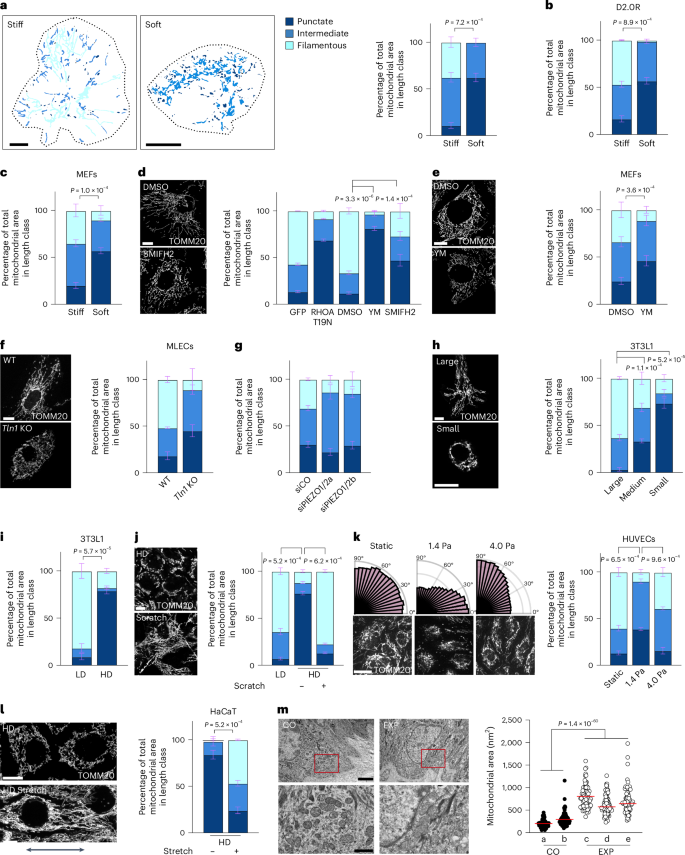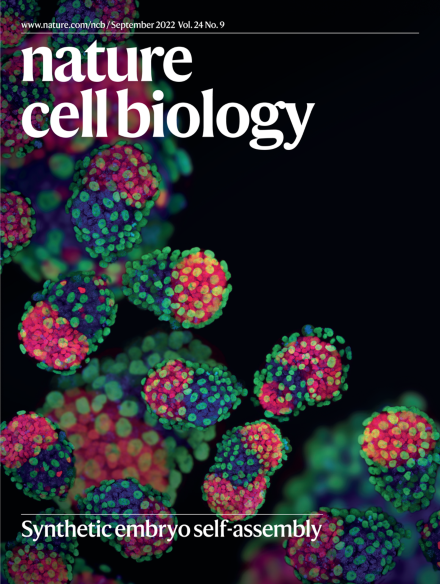Mitochondrial mechanotransduction through MIEF1 coordinates the nuclear response to forces
IF 17.3
1区 生物学
Q1 CELL BIOLOGY
引用次数: 0
Abstract
Tissue-scale architecture and mechanical properties instruct cell behaviour under physiological and diseased conditions, but our understanding of the underlying mechanisms remains fragmentary. Here we show that extracellular matrix stiffness, spatial confinements and applied forces, including stretching of mouse skin, regulate mitochondrial dynamics. Actomyosin tension promotes the phosphorylation of mitochondrial elongation factor 1 (MIEF1), limiting the recruitment of dynamin-related protein 1 (DRP1) at mitochondria, as well as peri-mitochondrial F-actin formation and mitochondrial fission. Strikingly, mitochondrial fission is also a general mechanotransduction mechanism. Indeed, we found that DRP1- and MIEF1/2-dependent fission is required and sufficient to regulate three transcription factors of broad relevance—YAP/TAZ, SREBP1/2 and NRF2—to control cell proliferation, lipogenesis, antioxidant metabolism, chemotherapy resistance and adipocyte differentiation in response to mechanical cues. This extends to the mouse liver, where DRP1 regulates hepatocyte proliferation and identity—hallmark YAP-dependent phenotypes. We propose that mitochondria fulfil a unifying signalling function by which the mechanical tissue microenvironment coordinates complementary cell functions. Romani et al. show that matrix stiffness, confinement and applied forces impact mitochondrial dynamics and DRP1- and MIEF1-dependent mitochondrial fission regulates transcription factors in response to mechanical cues.


线粒体机械传导通过 MIEF1 协调核对力的反应
组织尺度的结构和机械特性指导着细胞在生理和疾病条件下的行为,但我们对其潜在机制的了解仍然很片面。在这里,我们展示了细胞外基质硬度、空间限制和外力(包括小鼠皮肤的拉伸)对线粒体动力学的调节作用。肌动蛋白张力促进线粒体伸长因子 1(MIEF1)的磷酸化,限制线粒体中的达因明相关蛋白 1(DRP1)的招募,以及线粒体周围 F-肌动蛋白的形成和线粒体的裂变。引人注目的是,线粒体裂变也是一种普遍的机械传导机制。事实上,我们发现 DRP1 和 MIEF1/2 依赖性裂变需要并足以调控三个具有广泛相关性的转录因子--YAP/TAZ、SREBP1/2 和 NRF2,从而控制细胞增殖、脂肪生成、抗氧化代谢、抗化疗和脂肪细胞分化,以响应机械信号。这延伸到了小鼠肝脏,DRP1 在肝脏中调控肝细胞增殖和依赖 YAP 的特征表型。我们认为线粒体具有统一的信号功能,通过这种功能,机械组织微环境可以协调互补的细胞功能。
本文章由计算机程序翻译,如有差异,请以英文原文为准。
求助全文
约1分钟内获得全文
求助全文
来源期刊

Nature Cell Biology
生物-细胞生物学
CiteScore
28.40
自引率
0.90%
发文量
219
审稿时长
3 months
期刊介绍:
Nature Cell Biology, a prestigious journal, upholds a commitment to publishing papers of the highest quality across all areas of cell biology, with a particular focus on elucidating mechanisms underlying fundamental cell biological processes. The journal's broad scope encompasses various areas of interest, including but not limited to:
-Autophagy
-Cancer biology
-Cell adhesion and migration
-Cell cycle and growth
-Cell death
-Chromatin and epigenetics
-Cytoskeletal dynamics
-Developmental biology
-DNA replication and repair
-Mechanisms of human disease
-Mechanobiology
-Membrane traffic and dynamics
-Metabolism
-Nuclear organization and dynamics
-Organelle biology
-Proteolysis and quality control
-RNA biology
-Signal transduction
-Stem cell biology
 求助内容:
求助内容: 应助结果提醒方式:
应助结果提醒方式:


